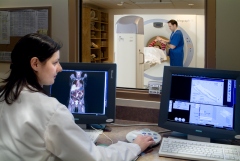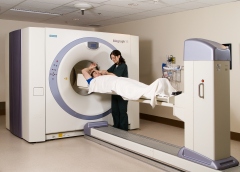Functional Cancer Imaging research
September 29, 2010
Found in PET/CT scan, Radiation Oncology, Radioisotopes
Another part of my work is to lead an active research group on “Functional Cancer Imaging.” The purpose of my research is to improve and develop new methods to detect and characterize cancers by using tumor-seeking probes instead of simply looking for tumour masses using conventional means.
Part of this includes evaluating which patients gain the most benefit fromPET/CT scans performed using radioactive glucose. This is something we already use in the clinic and we are looking at means to improve the current procedures.
I also conduct clinical trials to see how we can improve clinical care by introducing new imaging methods in the clinic. One such example is a study financed by the U.S. National Institutes of Health. (Yes, they do fund research outside the U.S. when the project is found to be exceptional.) We are trying to find out whether 18F-Fluoroestradiol (FES), an imaging agent that mimics estrogen, can predict whether women with breast cancer will respond to hormone therapy.
Hormone therapy is more easily tolerated than chemotherapy for most women but works in only 30% of cases when the cancer comes back. The current approach is to try the treatment and switch to chemotherapy after a few months if it does not work. We are trying to see if a PET/CT scan done before treatment could provide the same information much sooner.
My lab also develops new probes or tracers for PET/CT imaging. Some slow growing cancers, such as prostate cancers and some breast cancers, do not metabolize glucose as much as other cancers. We are exploring novel probes that bind to proteins found only on breast and prostate cancer cells. If proven successful, new probes could allow us to detect these cancers earlier than we currently can with existing methods.
As there are lots of abnormal proteins that are found in cancer cells but not normal cells, this is a very exciting area of research. The genomic and proteomic revolutions in research are rapidly increasing our understanding of cancer, and new targets for both imaging agents as well as anticancer drugs are identified at a very rapid pace.
François

State-of-the-Art Scanning Technology a First for Canada
Support BC Cancer – Vancouver’s Technology Transformation — a suite of best-in-class diagnostic, imaging and radiation equipment, including the Next Gen PET/CT.
Donate Today
